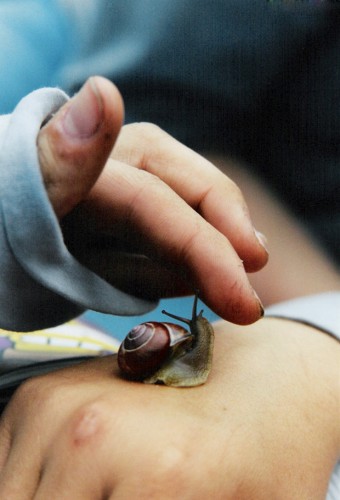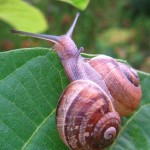Tonight, if we can remember the words, we might be singing about auld acquaintance. And we have many: several People of LWON–Heather Pringle, Erika Check Hayden and Thomas Hayden–moved on in 2013 (and Virginia Hughes just before that). We miss them all.
So I thought I’d try to bring at least one of these fine folks back into the fold, if only for a day. Here’s one I wrote about snails a while back, and the slideshow response from the snails of the Hayden garden. We won’t forget any of our old acquaintances, our fine writers, our friends–but if I forgot some of those snail images, I wouldn’t mind so much. 
Snail Season
It is springtime, and the snails are upon us. They are upon the lemon leaves, and the stucco walls, and the umbrella stand. Somehow, they are upon the closet doors, which happen to be inside the house. They are upon the roof rack of the car as it travels six hundred miles north to Mount Shasta, and they emerge unscathed.
Beware to the person who steps barefoot into the grass at midnight. The ten yards to the bathroom now seems much preferable to the sickening crunch of a shell beneath the heel.
This is the first place I’ve lived that had so many snails. During the first few years in this house, I heard an odd sound at night, a cross between a scratch and a squeak.
One rainy evening, I looked up. Dozens of snails slid along the greenhouse that shelters our dining room table. (The greenhouse is the addition of the man who lived here previously. I have been to his new house, where he installed an even larger one, facing west. Ours, a prototype, is south-facing, and in the winter it is lovely and warm. In the summer, it is hot.)
The brown garden snail lays as many as 80 eggs a month, and can breed six times each season. No wonder it feels as if we’re being overrun.
We planted three successive patches of sunflowers the summer before last. Each time, the shoots pushed up hopefully through the ground. Then they vanished in a single night. Only when we put a band of copper around them did they grow to tower over the greenhouse, blocking out some of the sun.
The copper works, people think, by creating a response in the snail’s nervous system that’s like an electric shock when the snail’s slimy foot crosses its path. But this technique has now reached its limit—it seems unreasonable to fence our yard entirely in copper. So last month, I bought a “natural” snail defense that I sprinkle around the base of the lemon and lime and blood orange trees.
At first I thought this was a deterrent just like the copper. But once I sat down to do some reading, I learned that the iron phosphate I’ve been shaking on like powdered sugar makes the snails ramp up their mucous production. Their metabolism slows, their bodies slow, and they find a place to die. A shiver rattled down my spine.
I am a hypocrite, I know. My primary method of snail destruction is to send them off to an uncertain end in the green waste bin. They likely feast until the truck from the city arrives, and then, I imagine, they meet the fate that Luke Skywalker and friends narrowly escaped.
I’ve never tried using two of my favorite things—caffeine and beer—as snail repellent. The caffeine may be toxic to the snail’s nervous system; the fermenting sweetness draws the snails in close, and then they drown. I’ve never tested either of these, perhaps because I don’t want to share, perhaps because the effect on snails is too similar to the effect on me.
 I could try stopping snails with snails. The decollate snail, with its long, elegant shell, has the good taste to feast on the eggs and young of brown garden snails. (Unlike me—even though brown garden snails were introduced to be a food source, and could become high-protein, low-fat escargot, I have no desire to make them part of my garden’s bounty.) I live in one of the citrus-growing counties where the decollate snail has been approved for use.
I could try stopping snails with snails. The decollate snail, with its long, elegant shell, has the good taste to feast on the eggs and young of brown garden snails. (Unlike me—even though brown garden snails were introduced to be a food source, and could become high-protein, low-fat escargot, I have no desire to make them part of my garden’s bounty.) I live in one of the citrus-growing counties where the decollate snail has been approved for use.
The idea is appealing. The idea of even more snails in my yard, both of which eat lettuce, is not.
In fact, there are so many ways for snails to die that I started feeling a bit sorry for them. In truth, land snails are tiny warriors, nearly every part of their bodies fighting a battle against evaporation. Their shells shield their thin-skinned bodies; their slime attracts water; they can crawl on the edges of their feet to reduce water loss; they can estivate during heat and drought.
And yet, it had been raining all weekend, and the only afternoon activity that sounded appealing to the resident three-year-old was a snail hunt. I picked them off of stucco walls and garden fences, off lemon leaves and lime-colored buckets. I lifted them carefully by the fragile shells. I pulled gently until they released their feet. I pointed out the four tentacles that help snails see and smell.
My son asked if he could look at the foot of the snail, and so we peered closer. The edges of the snail’s foot rippled like a ribbon. I thought about how finely balanced snails are, how small in a world of crows and droughts and hands that appear out of nowhere. And then carefully, so carefully, I dropped each one into the green waste bin.
**
Snail Season: The San Fran Remix
Thomas Hayden
When Cameron delivered the last word on brown garden snails — great, biblical swarms of the things — I knew I’d have to respond, and visually too, since she said it all so well. I do battle with the demon mollusks a few hundred miles north of Cameron’s besieged garden, as the images above attest. I don’t know whether we’ve got quite the volume of the creatures she gets, but there have been nights when I’ve captured a kilogram’s-worth or more. Like Cameron, I can’t quite bring myself to eat them, though I know they are fed on the finest organic greens and seedlings. But I’m not so gentle as she when it comes to relocation — mine go straight into the home compost pile, so I’m getting their nutrients one way, if not the other.
When I first encountered the snails a few years ago, I was delighted and mesmerized. But as their numbers increased with the spring rains, the shoots and leaves in my garden disappeared and the slime trails on the patio multiplied into superhighways, my joy turned to concern, and concern first to horror and then, finally, to grim deadly determination. I am heartless now in my persecution of the snails — I have become hardened, numb to the brutality I mete out most every night. I have lost a part of my soul, in other words, but I have gained a whole world of salad. We all must live with the bargains we make.
**
Snail Season images: Steven Strehl (top) Ciar (bottom)
Snail Season: The San Fran Remix Music by Nimbleweed. Golden Gate Bridge. Photo by Rich Niewiroski Jr., Wikimedia Commons.
Miss you guys, too! Happy 2014 at LWON!
It’s lovely to be back, if just for a snail’s breath of time. May LWON have a slime-free 2014!